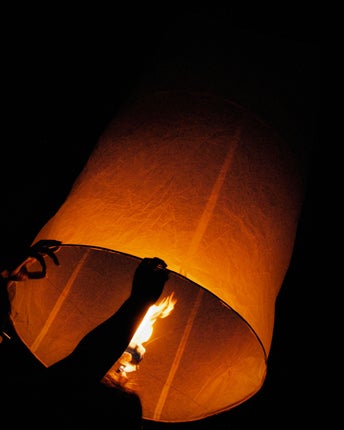Red sky at night, coastguards' fright
Maritime authorities are having to deal with a spate of false alarms as Chinese lanterns are mistaken for distress flares.

In just a year they have become the must-have item to end any summer party: Chinese lanterns which drift glowing into the night sky as revellers watch from below.
The delicate paper balloons – which are powered and illuminated by candles and have become increasingly popular at weddings, birthdays and other celebrations – bring immense pleasure to those who release them. They are also accused of wreaking havoc on the British countryside.
Coastguards say the lanterns, which are sometimes released in their hundreds, are frequently mistaken for distress flares by members of the public. Just this weekend, 12 such incidents were reported across the UK.
In Scotland, Forth Coastguard responded to three alerts, and even launched a lifeboat to search a stretch of coast near Cockenzie, East Lothian. Further coastguard teams were scrambled after multiple reports of red and white flares in the sky over Bamburgh in Northumberland on Saturday night.
"For us, a red flare going up over the coast means that someone is in trouble," says Maggie Hill of the Maritime and Coastguard Agency. "If someone sees a red lantern and reports it as a red flare we have a duty to investigate. So a £15 lantern might end up costing us thousands of pounds, and the RNLI thousands of pounds of charity money, in order to search an area and conclude it was a false alarm."
Although such an error might seem unlikely, the lanterns sometimes rise thousands of feet if caught by the wind, by which time they can be indistinguishable from flares. The MCA has requested anyone releasing them near the coast to contact them beforehand, but even if they are aware of an event happening nearby, they cannot ignore any potentially genuine distress signals.
The lanterns, which can cost as little as £2 each and can travel for up to 30 miles before burning out and falling back to earth, are seen as a cheap alternative to fireworks. They are also safer, quieter and more environmentally friendly as they do not contain plastic, only a biodegradable metal wire which holds the candle.
This has not prevented them from provoking the wrath of farmers, who say the wires, which occasionally fall in their fields, pose a danger to their cattle. According to the National Farmers' Union and the RSPCA, the wires could be accidentally collected when grass is gathered to produce silage and subsequently fed to the animals in winter. "We've been alerted to a couple of examples of this," said an RSPCA spokesman. "If swallowed, the wire would cause extreme discomfort to the cow. There may be an occasion where it would be fatal, depending on how much of the wire was eaten." Robert Sheasby, a rural surveyor at the NFU, said he had been contacted by one farmer who had picked 50 of the lanterns out of one field. Many are also concerned that the falling lanterns could cause their crops to catch fire.
"We're approaching harvest time when crops are turning golden brown, and if something comes down which is very hot, or possibly even still alight, it poses a fire risk," he said. "If you've got a wedding venue not too far away and the prevailing wind directs them your way, they could be coming down every Saturday and Sunday throughout the summer."
The lanterns have already been banned in three German states after a series of incidents. Earlier this year, a 10-year-old boy died in a house fire caused by a Chinese lantern in North Rhine-Westphalia, and just this month a couple celebrating their marriage set fire to two houses in Dieburg, causing £250,000 worth of damage.
Grant Barry is the managing director of Sky Lanterns, which has been in business for seven years and is now one of the UK's leading suppliers. He said improvements to the lanterns were being made every year, but ultimately it was up to his customers to use the products they bought responsibly.
"We did have a complaint when a few dozen of them landed on a farmer's field," he said. "Nothing happened to the animals but I did understand his concern. We're always looking to improve the products – we made the paper on the lanterns fire retardant two years ago – but it does take time and research." Mr Barry added that he would advise his customers to refrain from releasing red lanterns near the coast in future, in an attempt to help the coastguard.
The lanterns have also triggered a number of UFO sightings, most notably above the village of Noak Bridge in Essex, where public alarm was only put to rest after a woman came forward to admit she had released them during her 40th birthday party.
Chinese lanterns: The first hot air balloons
Chinese lanterns were invented in the 3rd century when they were used as a military signal and are believed to be the first example of a hot air balloon. During the Yuan dynasty of the 13th century, they became a symbol of good wishes in China but people now use them to celebrate special occasions. They have become increasingly popular in the UK since the 2002 Bali bombings, when they were released to pay tribute to the 182 dead.
Join our commenting forum
Join thought-provoking conversations, follow other Independent readers and see their replies
Comments